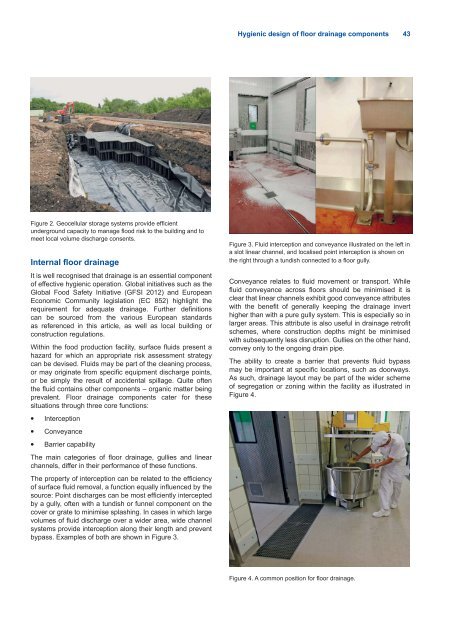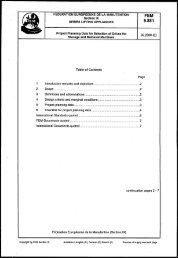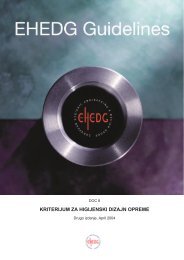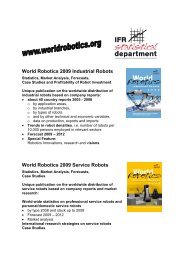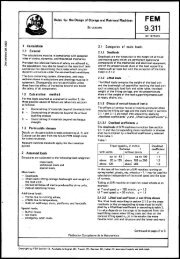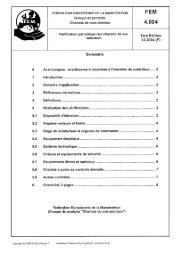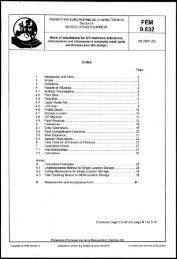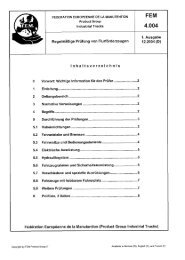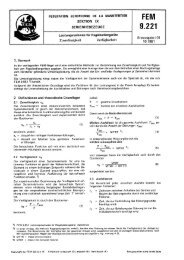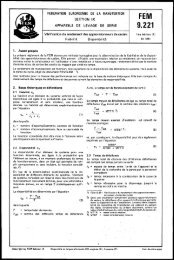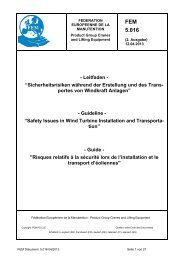European Hygienic Engineering & Design GroupHygienic design of oor drainage componentsDrainage is a critical component affecting the hygienic performance of food production facilities.This article considers surface drainage holistically at site level initially before focusing internally<strong>to</strong> look at how features within the drain component itself might elevate hygienic performance.Martin Fairley, AC Technologies plc, e-mail: mfairley@aco.co.uk, www.aco.co.ukDrainage is a critical component that affects the hygienicperformance of food production facilities. Effective drainagehelps mitigate hazards from the external environment andis central <strong>to</strong> the safe and hygienic operation internally.Floor drainage specically provides three basic functions– interception, conveyance of uids, and the ability <strong>to</strong> actas a barrier. Despite its importance, relatively few academicstudies have focused on hygienic attributes of oor drains.Of greater concern are the numerous examples of drainageinstallations that exhibit some capacity <strong>to</strong> be termedhazardous. This is often a result of a oor-drain interfaceissue, but can equally apply <strong>to</strong> the component designitself. This article considers surface drainage holistically atsite level initially before focusing internally <strong>to</strong> look at howfeatures within the drain component itself might elevatehygienic performance.Such holistic consideration of drainage is necessary forany operation, but becomes critical where hygiene is ofimportance. While surface water sewers are now morecommon, many countries have a substantial legacy ofcombined surface and foul drainage systems of xedand often inadequate capacity. Should such a systemsurcharge – due <strong>to</strong> inux of large amounts of surface water sewer backow may occur. The risk can be managedthrough specication of adequate backow preventiondevices. Optimally, these sense backow and au<strong>to</strong>maticallyclose, re-opening once the event has subsided. Figure 1illustrates such a device with the necessary twin valves,one operated by external power, in accordance with EN13564 type 3,Site level drainage considerationOf course, drains serve both internal and externalrequirements and it is worthwhile reviewing the increasingfocus on external drainage design. Many countries nowacknowledge the impact of changing weather patterns andthe implications for surface water management. The EUFlood Directive (2007) initiated local ood risk managementplans that spurred specic legislation related <strong>to</strong> this growingexternal hazard. In England and Wales, for example, theFlood and Water Management Act (2010) empowers localgovernment <strong>to</strong> coordinate ood risk management, and thistranslates directly <strong>to</strong> planning requirements that must besatised before building work commences.The implication for newly built construction is far more focusedon mitigating ood risk <strong>to</strong> people and property. At site levelthis requires consideration of a number of potential (model)s<strong>to</strong>rm events and drainage design <strong>to</strong> accommodate them.Ultimately, the degree <strong>to</strong> which the risk is managed is a choiceof the building opera<strong>to</strong>r. S<strong>to</strong>rm events are commonly speciedby their frequency, duration and intensity; for example,it is necessary <strong>to</strong> consider the impact of a 1100-year (1%probability) s<strong>to</strong>rm in England, the duration and intensity ofwhich will depend upon the geographical area selected inthe model. The building opera<strong>to</strong>r may choose <strong>to</strong> manageless probable events; in other words, a 1200-year (0.5%probability) event logically produces greater water volumes,and therefore an appropriate drainage design should follow.As may be appreciated, these new challenges <strong>to</strong> site designare accommodated in newly built construction. Existingfacilities may well benet from an engineering assessmen<strong>to</strong>f their drainage via a qualied professional conversant withlocal regulation, as many of the techniques used in a newlybuilt construction can be retrotted <strong>to</strong> existing sites.Figure 1. A sewer backow prevention device.In more modern schemes, site connection will be <strong>to</strong> surfacewater sewer only, and in many cases, no sewer at all. Insuch situations the risk of building ooding can be reducedby accommodating more s<strong>to</strong>rm water in the now ubiqui<strong>to</strong>us<strong>und</strong>ergro<strong>und</strong> geocellular s<strong>to</strong>rage devices as shown in Figure2. Furthermore, the building opera<strong>to</strong>r may request that hisor her designer does not allow car parks or other areas ofthe production facility <strong>to</strong> be designated as ‘ood s<strong>to</strong>rage,which is becoming a common approach. Although in manycases this may be entirely justied on the gro<strong>und</strong>s of costavoidance, food production facilities may prefer <strong>to</strong> adoptalternative measures. In any case, it is necessary <strong>to</strong> specifyadequate freeboard over the expected ood level withrespect <strong>to</strong> the building oor.
Hygienic design of floor drainage components 43Figure 2. Geocellular s<strong>to</strong>rage systems provide efcient<strong>und</strong>ergro<strong>und</strong> capacity <strong>to</strong> manage ood risk <strong>to</strong> the building and <strong>to</strong>meet local volume discharge consents.Internal oor drainageIt is well recognised that drainage is an essential componen<strong>to</strong>f effective hygienic operation. Global initiatives such as theGlobal Food Safety Initiative (GFSI 2012) and EuropeanEconomic Community legislation (EC 852) highlight therequirement for adequate drainage. Further denitionscan be sourced from the various European standardsas referenced in this article, as well as local building orconstruction regulations.Within the food production facility, surface uids present ahazard for which an appropriate risk assessment strategycan be devised. Fluids may be part of the cleaning process,or may originate from specic equipment discharge points,or be simply the result of accidental spillage. Quite oftenthe uid contains other components – organic matter beingprevalent. Floor drainage components cater for thesesituations through three core functionsInterceptionConveyanceBarrier capabilityFigure 3. Fluid interception and conveyance illustrated on the left ina slot linear channel, and localised point interception is shown onthe right through a t<strong>und</strong>ish connected <strong>to</strong> a oor gully.Conveyance relates <strong>to</strong> uid movement or transport. Whileuid conveyance across oors should be minimised it isclear that linear channels exhibit good conveyance attributeswith the benet of generally keeping the drainage inverthigher than with a pure gully system. This is especially so inlarger areas. This attribute is also useful in drainage retrotschemes, where construction depths might be minimisedwith subsequently less disruption. Gullies on the other hand,convey only <strong>to</strong> the ongoing drain pipe.The ability <strong>to</strong> create a barrier that prevents uid bypassmay be important at specic locations, such as doorways.As such, drainage layout may be part of the wider schemeof segregation or zoning within the facility as illustrated inFigure 4.The main categories of oor drainage, gullies and linearchannels, differ in their performance of these functions.The property of interception can be related <strong>to</strong> the efciencyof surface uid removal, a function equally inuenced by thesource Point discharges can be most efciently interceptedby a gully, often with a t<strong>und</strong>ish or funnel component on thecover or grate <strong>to</strong> minimise splashing. In cases in which largevolumes of uid discharge over a wider area, wide channelsystems provide interception along their length and preventbypass. Examples of both are shown in Figure 3.Figure 4. A common position for oor drainage.


